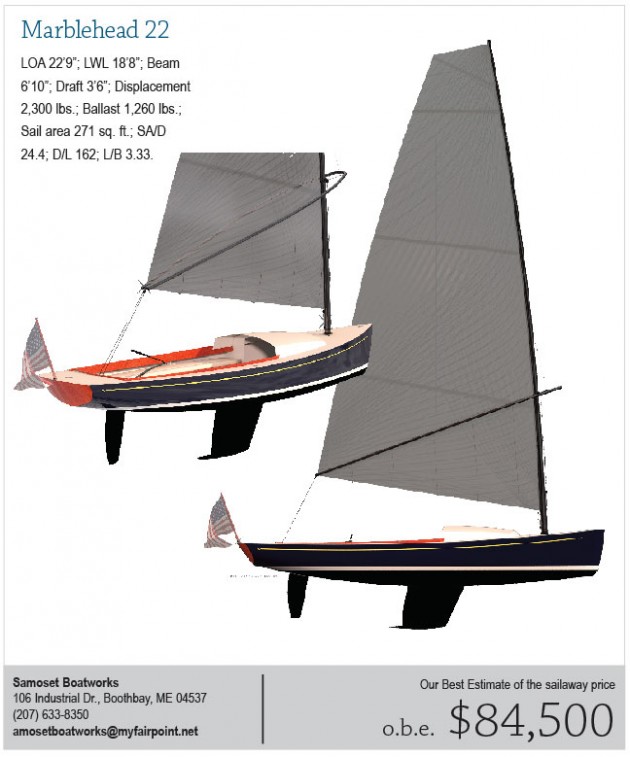Marblehead 22
Daysailer
Many years ago a young fellow popped into my office one day and introduced himself as Doug Zurn. Doug expressed an interest in yacht design so we hit it off well. I patiently waited for Doug to ask me about a job. I finally asked him, "Are you looking for a job?" "No," he said, "I'm going to set up my own office." Well, he did, and it's obvious by his output that he sure didn't need a job with me. Ironically, most of Doug's work has been in powerboats, but he's a sailor and his real love is designing sailing yachts. That said, his powerboats are very beautiful.
This 22-foot daysailer grew out of Doug's very first design commission several years ago. The idea was for a very simple and efficient daysailer. When I look at this design I see the perfect old man's one-design racer. The crew could be your granddaughter. What could be better than zooming around the race course in this pretty vessel teaching your kids or grandkids the joys of sailing? "Gee, Grandpa, this is fun. Did we win?" I like that picture. I also really like the looks of this boat.
Sheers: Some guys can draw them and some can't. Doug can draw a sweet sheer and the 22 shows it. Look at the sailplan. The sheer is a well-proportioned line that looks very natural on the boat. The hull shape is moderate with deadrise from forefoot to transom. The topsides show some fullness and this is important for form stability. The shape in the topsides also makes the boat look good. It's fun to see a good designer bend shapes and control contours while not losing any performance. There are some boats out there that are so plain I feel like calling the EPA on them. Note the sharp knuckle on the forefoot. I'd probably have softened that a wee bit but it does pull the V-ed entry well forward the way Doug has it. The long counter aft terminates in a shapely transom and the deadrise aft prevents the transom from looking blocky. If you carry a firm turn to the bilge aft it might be fast but combined with a conventional transom rake it is usually ugly. The D/L is 162 and the L/B is 3.33. Draft is a modest 3 feet, 6 inches with 1,260 pounds of lead in a beaver-tailed bulb keel.
Back to the sailplan. The drawing I have shows the bow on the left. I draw all my sailplans with the bow on the right. That's standard. I asked Doug why he flipped the sailplan. The rest of his drawings have the bow on the right. I brought up the fact that for most of us flipping the profile makes the boat look different. I'm not sure why. Maybe it's the way your eye reads things. I actually prefer the look of the design with the bow on the left but I'm afraid to start drawing that way. Doug agreed. He wasn't sure why he flipped it and finally said, "Maybe I just liked the way it looked better that way." Doug thought that after drawing the rest of the boat with the bow on the right maybe flipping it just gave the design a "fresh" look. I'm not sure. But I sure like the look of this sailplan. The free-standing spar is carbon fiber by Hall Spars and they worked with North Sails to get the combo right. The square-topped main on a free-standing stick gives you a rig that de-powers easily in the puffs, so no reefing is required. Old guys like the sound of that. Sailing the 22 is a "one string" operation. You can jibe intrepidly without worrying about the boom clocking you. You don't need a vang because the wishbone boom provides that vector. Luff tension is easily adjusted with the multiple-purchase downhaul at the tack. The SA/D is 24.4, and that should be good for keeping the 22 moving in the lightest of air. I like this rig because it has a "snotter" that controls the boom position on the mast. Imagine telling your granddaughter to "Ease the snotter, darlin'." "Oh, Grandpa, you say the funniest things."
The builder of the 22 is Samoset Boatworks of Boothbay, Maine. Construction is cold-molded Western red cedar diagonal skins over longitudinal strips. There are Douglas fir floors in way of the keel. Bulkheads are Okume plywood. There is a single-point lift system for the boat so you easily can keep it in dry storage.

Comments